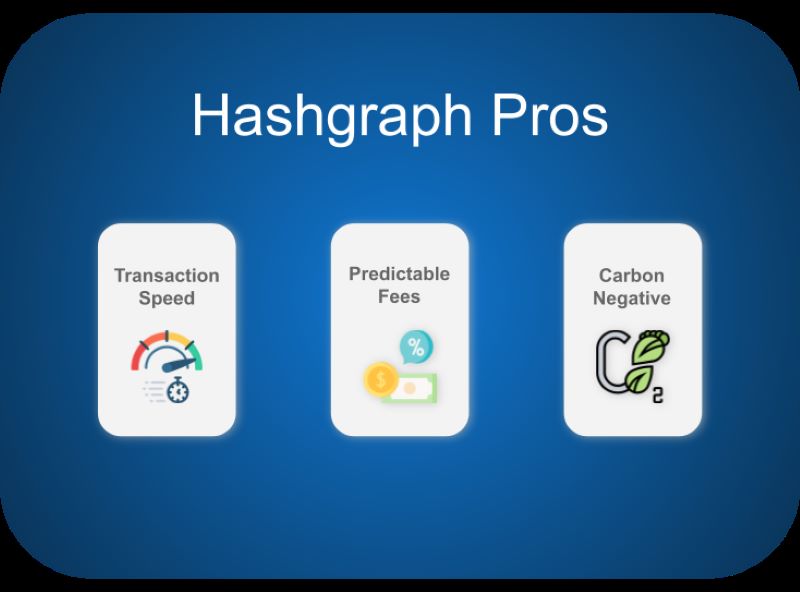Hashgraph Consensus Demystified: Blockchain’s Future Unveiled
I hear you asking, “What is hashgraph consensus in blockchain?” Think of it as a superfast, fair new way to make sure everyone agrees in a network, without any one person in charge. It’s like blockchain but on steroids. No miners fighting to add blocks means it’s super quick and slices energy use down a lot. Imagine a world where you can trust digital actions like never before; that’s hashgraph for you. Ready to dive in and see why this could be the big next thing? Let’s unravel this tech marvel together.
Understanding Hashgraph: The Basics of a Pioneering Consensus Mechanism
The Fundamentals of Hashgraph Technology
Let’s dive into the world of hashgraph technology. If you love fast and safe online tech, hashgraph’s a star player you should know about. It’s a new kind of digital ledger, just like blockchain. But it has a twist—or let’s say, it has a gossip! Hashgraph uses what we call the Gossip about Gossip protocol. It’s a friendly chat where computers share what they know fast. They don’t just pass on the latest news; they share what they heard and from whom. It’s like a super-efficient game of telephone that never messes up the message.
In hashgraph, each computer, known as a node, talks to a few others. It happens quickly and randomly, spreading info like wildfire. Soon, every node gets the whole story without needing much power or time. Now, thanks to virtual voting, they don’t even vote like in other systems. They just know what the group would vote, by figuring out this gossip game. It’s a secret sauce for making sure they all agree, and it’s called consensus.
How Hashgraph Differs from Traditional Blockchain Models
Now, let’s compare hashgraph to our old friend, blockchain. Blockchain’s like a train made of locked boxes called blocks. Each block has important stuff inside, and they’re added one by one in a line. But there’s only one track. So if two trains arrive at the same time, only one gets through. This can make things slow, and sometimes it’s a bit unfair.
Hashgraph doesn’t make a single line of blocks. It’s more like a web, which in tech talk is a DAG—think of it as a tree with many branches. This matters because transactions—like sending crypto money—zip through many paths at once. We call this setup a distributed ledger, and it’s super fast and fair.
One more special thing about hashgraph is its security. It’s tough against tricks and hacks thanks to byzantine fault tolerance. That’s just a brainy way of saying it can handle some computers telling lies and still not mess up.
So, why don’t we see hashgraph everywhere yet? Well, it’s younger than blockchain. It also has its own club called the Hedera Governing Council. They protect the system and its rules. But the buzz is growing. Developers are eyeing hashgraph for things like keeping track of who owns what in a game or having a safer vote online.
And that’s your scoop on hashgraph! It’s an exciting field, and I’m always thrilled to share what makes it tick. It’s not just another blockchain alternative; it can lead the charge into a future where digital stuff moves safer, quicker, and fairer. Keep your eyes on it and watch as it starts to shake up the tech scene even more.
Delving into Hedera: The Power Behind Hashgraph Consensus
Features and Functions of the Hedera Hashgraph Platform
Imagine a digital world where we can trust each other again. That’s what hashgraph technology is about. It’s not like old blockchains. It’s new and zippy. The Hedera Hashgraph platform stands out in this tech. It’s fast, fair, and does not take much power.
Now, let’s chat about it being fast. The platform can handle many transactions. We’re talking thousands in seconds. It’s all thanks to its Gossip about Gossip protocol. This clever chatter spreads news quick as a wink. It’s like kids whispering in class, but way more useful.
Next up, fair play. Fair ordering of transactions is a big win here. No cutting in line. Every transaction gets a timestamp. So it’s like everyone gets a number at the bakery. And the virtual voting algorithm? That ensures this fairness without a fuss.
Remember I mentioned saving power? This platform shines here. Traditional blockchains chug energy like a truck. Hedera sips it like a bike. That’s because it does not need heavy work like mining. This makes Hedera a smart choice as we all try to go green. Hashgraph is not just any DAG-based consensus. It’s special. It’s built to link pieces of data into a stream. This forms a picture quicker than a jigsaw puzzle on a Saturday night.
The Role of the Hedera Governing Council in Hashgraph’s Success
Let’s not forget the folks behind the curtain. The Hedera Governing Council shapes the platform’s fate. These leaders come from diverse groups. They join hands to make sure things stay smooth. This council keeps an eye on the rules and the tech. They’re like the neighborhood watch, but for a digital village.
This council also adds trust. They’re not hidden in shadow. We know who they are, and that’s refreshing. They make decisions together. No one has too much say. It’s like a potluck dinner, where everyone brings a dish to share.
In short, Hedera’s hashgraph tech is shaping a new internet era. It’s not just talk. It’s being used for games, payments, and more. As a hashgraph whisperer, I see how it weaves trust into our online lives. It’s about connecting us all without the worry. And with the Council’s wise hands on the wheel, we’re in for a smooth ride. This is the hashgraph magic. It’s about linking up, speeding up, and standing strong together.
Beyond Gossip: Advancing Network Efficiency and Security
Exploring the Gossip about Gossip Protocol
Ever heard of kids passing secrets in a game of whispers? That’s kind of like the Gossip about Gossip protocol. Here’s how it works: imagine each person knows a bit of news. They each tell two friends, who then tell two others, and in no time, everyone knows the whole story. In hashgraph, this is how things zip around so fast!
Each time a piece of info or gossip shares news, it also shares what it heard last. This makes a web of who said what and when. It’s like having a complete history in one clever whisper game! We call this the hashgraph data structure. It’s complex, sure, but it’s super fast for making decisions in a network.
Now, think about your family making a choice—maybe where to eat out. Everyone has a say, right? In hashgraph, the virtual voting algorithm works a bit like that. It lets each computer, or node, have a voice without shouting out loud. It’s all based on that gossip history. Everyone “gets” the votes without real voting. That’s one way hashgraph helps transactions stay fair and in order.
Ensuring Security through Byzantine Fault Tolerance
Security sounds boring but stay with me—we’re talking about keeping the bad guys out of your digital piggy bank. Byzantine Fault Tolerance, or BFT, is like having the toughest door in town. It makes sure that even if some computers turn evil, or don’t agree, everything still works right. Each node in a network is like a guard, watching out for sneaky moves.
BFT in hashgraph checks lots of guards to see if they can trust the new info. If most guards give the thumbs up, they let the info pass. It’s tough for a hacker to fool so many guards at once. This is important for things like your digital money, or cryptocurrency, to stay safe.
What I love about hashgraph is how it thinks about tomorrow. It’s energy-smart, which means it uses less power than many blockchain alternatives. Less power, less cost, better for our planet—win-win-win! And it’s real fast too. It doesn’t waste time getting all the guards to talk and agree. They’re already up to speed with the gossip, so it’s quick and easy. Plus, it all happens at the same time, not one after another. This saves so much time!
Using hashgraph feels like you’re on the highway with no traffic, and blockchain can feel like a slow-moving line. When it comes to network efficiency, hashgraph’s way is like a breeze. Developers love it because it lets them build apps that work quickly and safely. And businesses? They get a ledger that’s not just secure, but super speedy for their clients.
That’s the nifty thing about this tech. It’s not just for the computer whizzes. It’s for everyone, making sure things like paying a friend for lunch or buying a song online is painless and fast. That’s the magic of hashgraph—keeping things efficient and secure for all of us.
Hashgraph in Action: Real-World Applications and Future Potential
Empowering Microtransactions and Fintech with Hashgraph
Money moves like magic on the internet nowadays. But sending small amounts can be slow and costly. This is where hashgraph technology shines. It makes tossing pennies across the web as easy as sending a text. Picture a world where you pay per page you read, or per second of streaming. That’s what microtransactions are. And hashgraph for developers means they can build this magic into their apps with less cost and more speed.
Now, let’s talk about fintech, the blend of finance and tech. Banks and businesses see hashgraph as a new buddy. Hedera Hashgraph platform is leading this charge. It’s like a digital ledger that’s faster, fair, and doesn’t need much power. No more waiting for that “payment sent” email. Hashgraph’s virtual voting algorithm makes sure your cash flies across the world quick and safe. It’s good news for your wallet and our planet.
The Scalability and Speed of Hashgraph in Financial Solutions
In the fintech world, bigger is better. More customers and transactions mean a need for speed and scale. Hashgraph is like the superhero of ledger technology. It doesn’t break a sweat, no matter how many people join the party. We call this scalability in hashgraph. And it’s a big deal because it means more people can use it at once without slowing down.
When you use a credit card, you wait for the bank to say “OK.” But what if this could take just seconds? That’s the speed of hashgraph. This is huge for businesses that want fast transactions in hashgraph systems. Imagine bidding in an auction and knowing if you won right away. This isn’t a dream—it’s what hashgraph vs blockchain is all about.
With hashgraph, you can also trust that no one is jumping the line. That’s the fair ordering of transactions. It’s like handing out numbers at a bakery. But instead of taking a number, you’re taking a spot in a digital line. This way, no one gets cut off, and nobody can cheat. It’s great for things like stock trades or property sales.
Up there, in the cloud, connecting hashgraph nodes together is secretly complex. But for users, it’s not rocket science. It’s just tap, send, done. Hashgraph data structure is like a web we can’t see but rely on every day. It’s changing how money moves in our new online lives. Each node talks to its pals, spreading information fast and wide. This is the Gossip about Gossip protocol at play. It’s like whispering a secret that flies through a room in an instant.
But what about keeping everything under lock and key? This is where byzantine fault tolerance comes in. You know how gems are safe in a vault? Well, in hashgraph, your transactions are the gems, and the vault is this fancy math that keeps bad guys out. Network security isn’t just good—it’s rock solid.
So here’s the deal: when it comes to the future of your money, hashgraph is the bright kid on the block. It’s not just a “maybe”; businesses are already diving in. Hedge funds, game makers, and even your local coffee shop could soon be part of this hashgraph ride. As our world goes more and more online, financial systems need to zip and zoom better than ever before. That’s what hashgraph promises. It’s not just tech talk. It’s the new way your piggy bank will work in this fast-moving world.
In this post, we’ve tackled Hashgraph, a fresh take on consensus in tech. We started with the basics, showing how it stands apart from old blockchain ways. Then, we dived into Hedera, the muscle that makes Hashgraph strong. We saw how its features work and how the Hedera council helps. After that, we looked at how Hashgraph chats to spread data fast and stays safe from attacks. Last, we explored how it helps with small money trades and big finance.
To sum it up, Hashgraph offers a new, fast, and secure way to reach agreement across networks. It’s not just fast talk; it’s built for action. It backs up big projects and tiny trades alike, all with top-notch speed and safety. As we move ahead, this tech could change how we handle money and data . Keep your eyes on Hashgraph—it’s shaping our digital future.
Q&A :
What exactly is a Hashgraph consensus in blockchain?
Hashgraph consensus is a distributed ledger technology that differs from traditional blockchain. It uses a consensus algorithm that allows for fast, fair, and secure online transactions even at massive scale. Instead of a linear sequence of blocks, hashgraph employs a directed acyclic graph (DAG) that enables more efficient processing of transactions and consensus.
How does Hashgraph consensus improve upon traditional blockchain technology?
Hashgraph consensus introduces a unique way of reaching agreement among nodes in a network, known as “gossip about gossip” coupled with “virtual voting”. This allows for consensus with minimal communication overhead, less complexity, and higher throughput compared to proof of work or proof of stake mechanisms in traditional blockchains.
Is Hashgraph consensus more secure than blockchain?
The security of Hashgraph consensus is considered high-grade due to its use of asynchronous Byzantine Fault Tolerance (aBFT), which ensures that the network can reach consensus even with malicious nodes present. This level of security is often touted as being superior to many blockchain consensus mechanisms which may not be aBFT.
Can Hashgraph scale better than traditional blockchains?
Yes, Hashgraph claims to offer unparalleled scalability due to its gossip protocol and virtual voting mechanism, which allow it to process hundreds of thousands of transactions per second. This is in stark contrast to popular blockchains like Bitcoin and Ethereum, which are typically limited to a significantly lower number of transactions per second.
What types of applications are best suited for Hashgraph consensus?
Hashgraph consensus is well-suited for applications that require high throughput, fast consensus, and robust security. This includes sectors like finance for payments and remittances, healthcare for managing sensitive records, and supply chain management for tracking goods efficiently. Its ability to handle high-volume, speedy transactions is a prime benefit for various industries looking to integrate distributed ledger technology.





